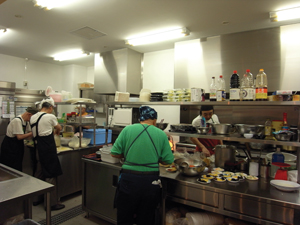Sanagi Cafeteria さなぎの食堂
|
Just a five-minute walk from the glitz and glamour of Yokohama’s Motomachi district lies a whole other reality. To Japanese and foreigners alike, the Kotobukicho area is hardly recognizable as a part of Japan. The contrast to the city surrounding it is stark and unbelievable. Kotobukicho’s modern history goes back to the end of WWII, when the land was occupied by a US military barracks. It then became a place to find day labor during the Korean War; the American forces began hiring locals on a casual basis to help move munitions to the port. From 1955, it became the preferred home of longshoremen engaged in temporary labor at the dock. The workers usually stay in “doya.” They are cheap, 3-tatami rooms with communal baths that cost about ¥1600-2200 per night. Some rooms have TVs, radios and windows, but kitchen facilities are rare. Most guests could afford to live in a normal home, but finding a guarantor is the biggest hurdle. These doya multiplied during the 1960s, 70s and 80s when migrant workers came to Kotobukicho from all over Japan to provide cheap labor for the construction boom and the port. Today there are about 120 doya operating in the area. These days the work has dried up, but the workers are still here. Most of the people in Kotobukicho are too old to continue to work in construction and they have little to occupy their time. Women are virtually absent. Kotobukicho has been cleaned up in recent years, but there is much to be done. The area houses an estimated 6500 people. About 85% are on welfare and about half are over sixty—many of the doya’s clientele are slowly dying off. But as is the case in Sanya, a similar neighborhood in Tokyo, some of the doya are turning into backpacker hostels (like Hostel Zen, to the right). Thankfully, there is some good news for these aging men. Some NPOs are working to make life better for the residents of Kotobukicho. One NPO has been running the Sanagi no Shokudo, a non-profit cafeteria, since 2002. Each day, about 400 people come to enjoy a hot, tasty meal in this clean, spacious restaurant. The meal costs only 300 yen. The NPO gets their food from donations. A sizable chunk of their donations includes food that has passed the expiration date but is still safe and nutritious. The bread, rice balls and other items that would otherwise be wasted from just two Lawson’s stores provides 10% of the food that Sanagi serves in the course of a day. They also assist Kotobukicho residents in finding medical care and other services from the city. When Sanagi staff recognize that a customer seems to be having trouble, they offer counseling in a room near the cafeteria. With cooperation from local hospitals, they help sick Kotobuki residents get the care that they need. Sanagi has recently been renovated and they are planning to start delivering food to the many Kotobukicho residents that are too sick to leave their rooms. All are welcome to come for a meal, and volunteers are also needed. |
華やかな雰囲気の元町から歩いて5分のところにあるもうひとつの現実。横浜市中区寿町に入ると、ここは日本か?という気分になる。近隣の華やかな街並みから一変してウソのように寂れた風景がそこにある。 戦後、この辺りには米軍のバラックがたくさん建てられた。そして朝鮮戦争の頃は日雇い労働者の町として栄えた。米軍が軍需品を港に運ぶのに地元の人々を雇ったのである。1955年以降は埠頭で働く日雇い労働者たちのための簡易宿泊所が建ち並んだ。 労働者たちは「ドヤ」と呼ばれる簡易宿泊所に寝泊りした。共同風呂がある三畳一間で一泊1600円~2200円。中にはテレビ、ラジオ、窓を備えたものもあったが台所は付いていないところがほとんどだった。普通のアパートに住めるくらいの経済力を持った労働者も多かったが、保証人が立てられずアパートを借りられなかったのである。建築ブームにも乗って、1960年代から80年代にかけて全国から出稼ぎ労働者がこの辺りにやってきて彼らのためにたくさんのドヤが作られた。寿町には今でも約120のドヤが並んでいる。 現在では、寿町の住人たちも高齢化が進んで仕事に出られない人が増えた。不景気の影響もあって仕事自体も大きく減っている。女性の住人はほとんどゼロ。寿町は再開発に力が入れられているがまだまだやり残されたことは多い。現在約6500人がこの地区に住んでいるとみられているが、その85%が生活保護を受けており、約半数が60歳以上の高齢者で、病気などで亡くなる人も多い。同じような状況にある東京の山谷ではドヤがバックパッカーのためのホテルとして転用されるケースも出てきているという。 いいニュースもある。寿町の住人のためにいくつかのNPO法人が活動しているが、そのうちの一つ「さなぎ達」が2002年から「さなぎの食堂」という店を運営し、暖かくて美味しい食事を安く提供している。定食が300円で食べられるこの食堂を利用する人は毎日400人に上るという。運営は寄付とボランティアによっている。また、コンビニエンスストア「ローソン」から余剰食品の提供も受けており、ローソンから提供されたパンやおにぎりなどの食材はさなぎの食堂で毎日供される食事の10%を占める。 またこれらのNPO法人は寿町の住人たちに対して医療・福祉面でのバックアップも行っている。さなぎの食堂にやってくる住人で体の具合の悪そうな人が居たらカウンセリングを行い、近所の病院の協力も得て、病気で苦しむ住人を助けるなどしている。さなぎの食堂は最近リニューアルし、調理場も広くなったのを機に、病気などで店まで来ることが出来ない住人のために食事の宅配サービスを始めることを検討している。お店は現在ボランティアで働いてもらえる人を探している。 |
さなぎの食堂 | Sanagi Cafeteria
横浜市中区寿町 2-7-7 神崎ビル 1 階
Naka-ku, Kotobuki-cho 2-7-7
Tel: 045-228-1055
www.sanagitachi.com
Fair Trade Product Review: Darjeeling Tea
|
Darjeeling tea comes from the Darjeeling region of West Bengal, India, and is widely considered one of the most delicious black teas. It has a floral aroma but slight spiciness as well. There are numerous reasons to drink it. There is of course the refined taste. There are also health benefits, like boosted immunity. Recently, with the appearance of Fairtrade Darjeeling, drinking it can also support the poorer communities that grow it. The Fairtrade label ensures that growers enjoy safe working conditions and fair prices. We are pleased to see major retailer Muji now carrying packages of Fairtrade Darjeeling. They contain 10 bags and cost only 294 yen. It may seem to many people that major retailers selling Fairtrade products is just an attempt to profit from a growing trend of conscientious consumerism. Do they really care about Fairtrade? We hope they do. What we do know is that when major retailers like Muji carry Fairtrade products, their visibility grows. By extension, the number of Fairtrade consumers may grow, too. |
インド東部西ベンガルのダージリン地方原産のダージリンティー。紅茶の中でも特に人気が高い銘柄で、フローラルな香りと微かにスパイシーな香りをあわせ持ち、洗練された味で免疫強化作用もあるとのこと。最近ではフェアトレード認定のダージリンティーも出てきているので、こうした紅茶を買うことにより生産国の貧しい農民たちの労働条件の向上にも貢献できる。 嬉しいことに「無印良品」でもフェアトレードのダージリンティーを扱い始めた。ティーバッグ10袋入りで294円とリーズナブル。大手小売店のこうした動きは単に良心的な消費者の購買傾向を当てこんだ利益追求にすぎず、実際にフェアトレードに賛同しているかどうか疑わしいとする向きもあるが、そんな心配は無用であると信じたい。無印良品のような大規模小売店がフェアトレード商品を置くことによりフェアトレードに対する認知度が上がることは間違いない。それでフェアトレード商品を買う人が増えてくれればそれでいいのだ。 |









